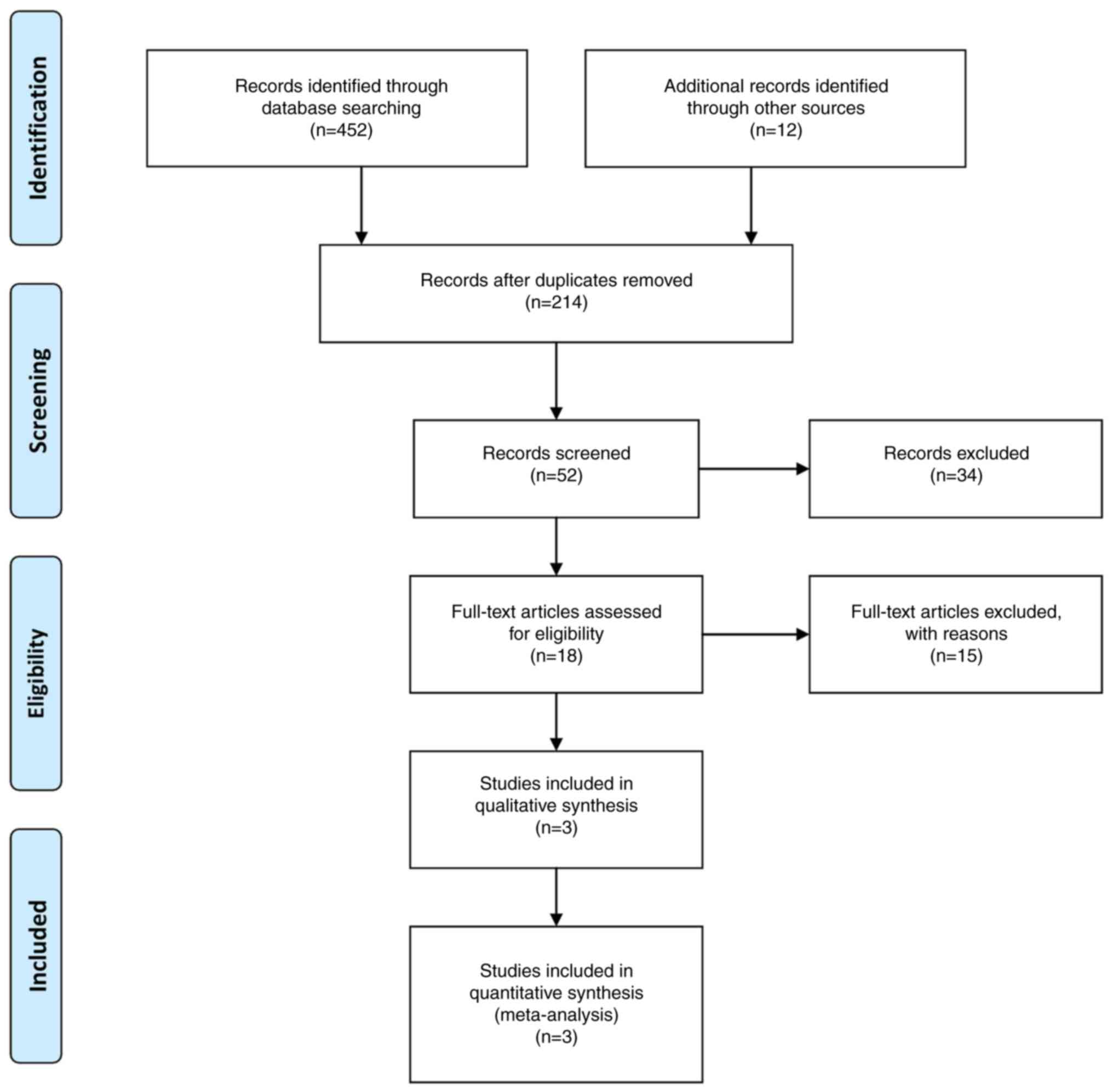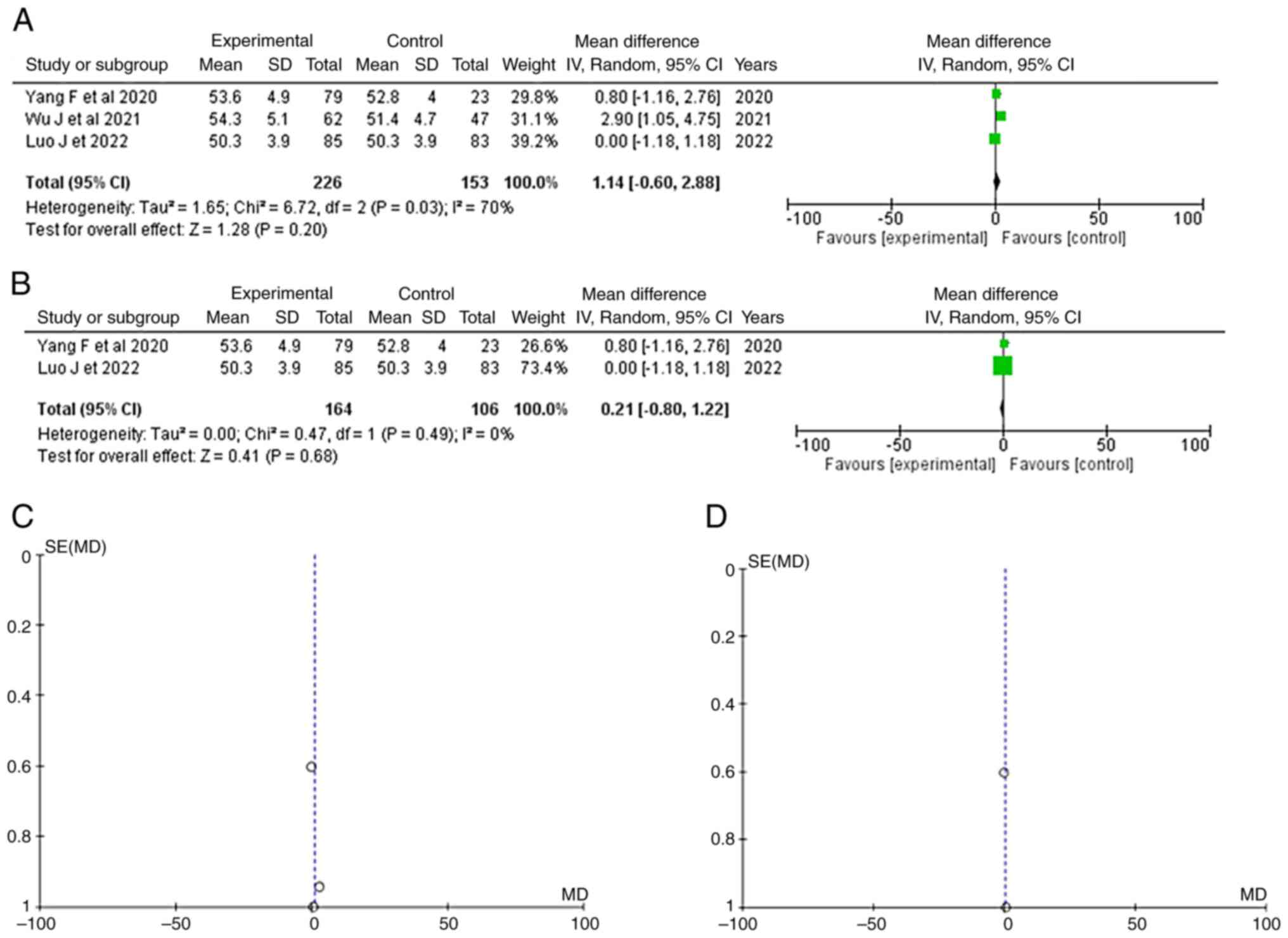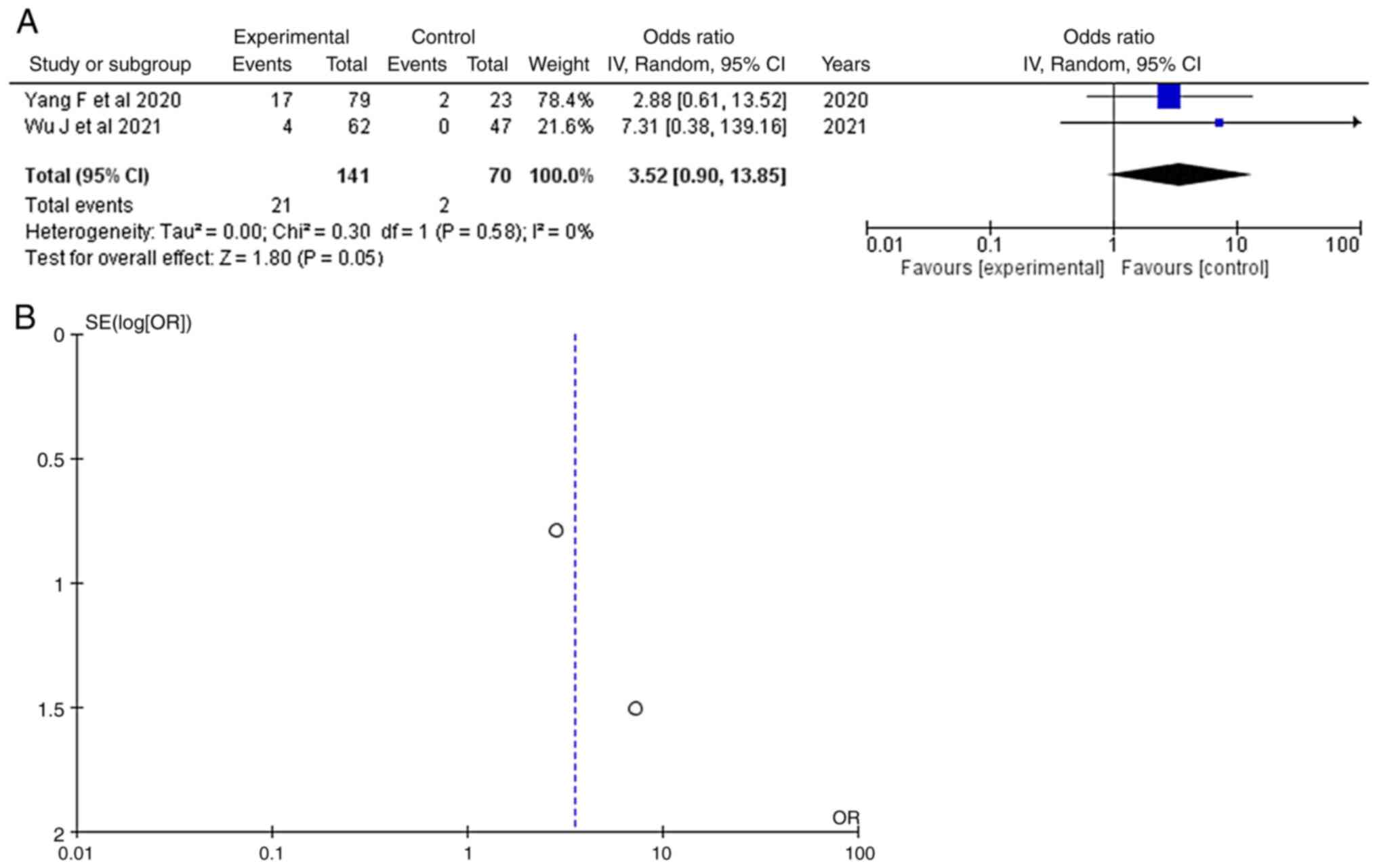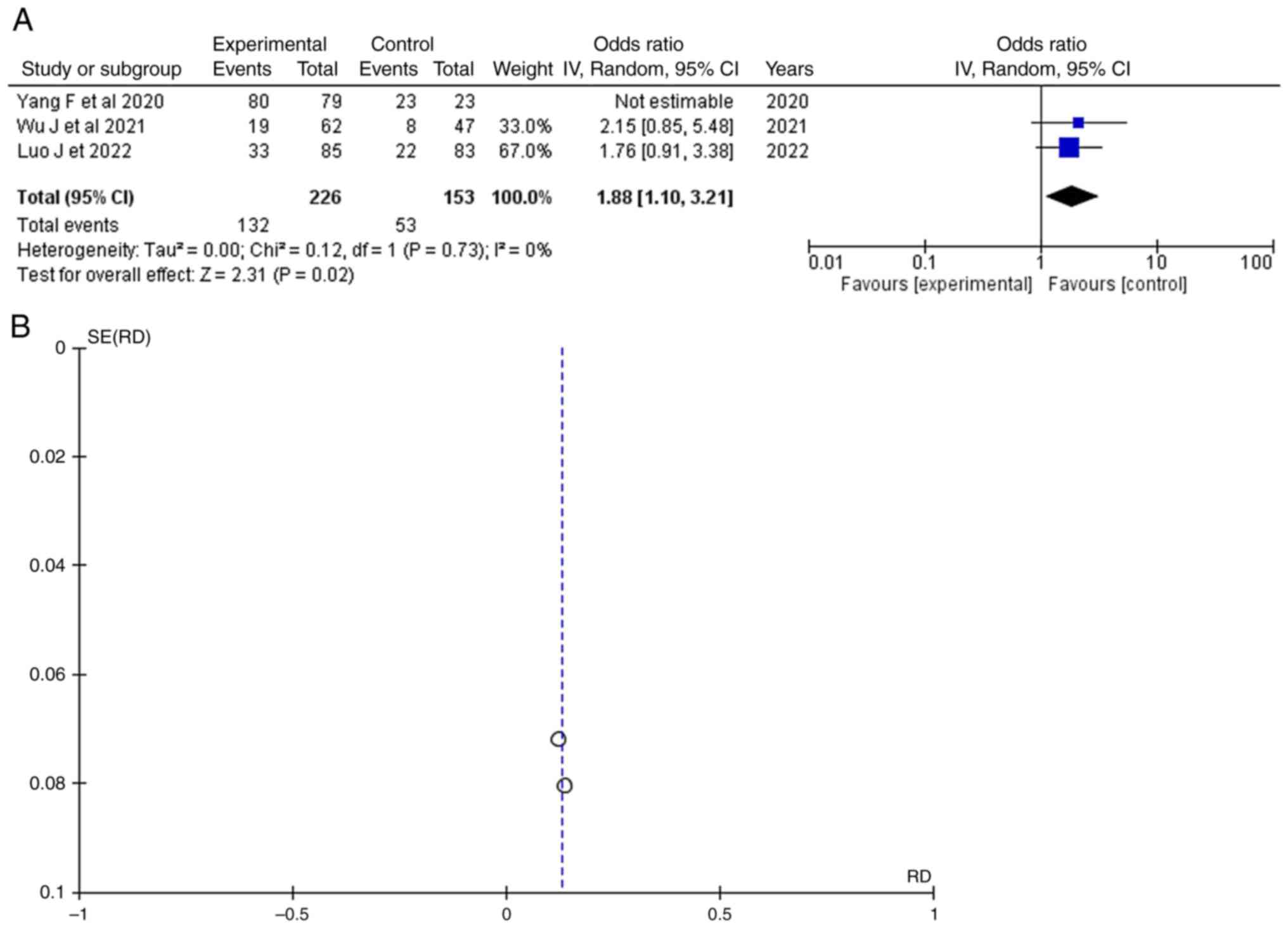|
1
|
Han H, Guo S, Jiang H and Wu X:
Feasibility and efficacy of enhanced recovery after surgery
protocol in Chinese elderly patients with intracranial aneurysm.
Clin Interv Aging. 14:203–207. 2019.PubMed/NCBI View Article : Google Scholar
|
|
2
|
Tsolaki V, Aravantinou-Fatorou A,
Georgakopoulou VE, Spandidos DA, Papalexis P, Mathioudakis N,
Tarantinos K, Trakas N, Sklapani P and Fotakopoulos G: Early
diagnosis of cerebral vasospasm associated with cerebral ischemia
following subarachnoid hemorrhage: Evaluation of computed
tomography perfusion and transcranial doppler as accurate methods.
Med Int (Lond). 2(34)2022.PubMed/NCBI View Article : Google Scholar
|
|
3
|
Fotakopoulos G, Makris D, Kotlia P,
Kapsalaki E, Papanikolaou J, Georgiadis I, Zakynthinos E and
Fountas K: The value of computed tomography perfusion &
transcranial doppler in early diagnosis of cerebral vasospasm in
aneurysmal & traumatic subarachnoid hemorrhage. Future Sci OA.
4(FSO313)2018.PubMed/NCBI View Article : Google Scholar
|
|
4
|
Ko NU, Rajendran P, Kim H, Rutkowski M,
Pawlikowska L, Kwok PY, Higashida RT, Lawton MT, Smith WS, Zaroff
JG and Young WL: Endothelial nitric oxide synthase polymorphism
(-786T->C) and increased risk of angiographic vasospasm after
aneurysmal subarachnoid hemorrhage. Stroke. 39:1103–1108.
2008.PubMed/NCBI View Article : Google Scholar
|
|
5
|
Dumont AS, Dumont RJ, Chow MM, Lin CL,
Calisaneller T, Ley KF, Kassell NF and Lee KS: Cerebral vasospasm
after subarachnoid hemorrhage: Putative role of inflammation.
Neurosurgery. 53:123–135. 2003.PubMed/NCBI View Article : Google Scholar
|
|
6
|
Starke RM, Kim GH, Komotar RJ, Hickman ZL,
Black EM, Rosales MB, Kellner CP, Hahn DK, Otten ML, Edwards J, et
al: Endothelial nitric oxide synthase gene single-nucleotide
polymorphism predicts cerebral vasospasm after aneurysmal
subarachnoid hemorrhage. J Cereb Blood Flow Metab. 28:1204–1211.
2008.PubMed/NCBI View Article : Google Scholar
|
|
7
|
Tsai PC, Liao YC, Wang YS, Lin HF, Lin RT
and Juo SHH: Serum microRNA-21 and microRNA-221 as potential
biomarkers for cerebrovascular disease. J Vasc Res. 50:346–354.
2013.PubMed/NCBI View Article : Google Scholar
|
|
8
|
Fotakopoulos G, Georgakopoulou VE,
Spandidos DA, Papalexis P, Angelopoulou E, Aravantinou-Fatorou A,
Trakas N, Trakas I and Brotis AG: Role of miR-200 family in brain
metastases: A systematic review. Mol Clin Oncol.
18(15)2023.PubMed/NCBI View Article : Google Scholar
|
|
9
|
Meeuwsen JAL, van T Hof FNG, van Rheenen
W, Rinkel GJE, Veldink JH and Ruigrok YM: Circulating microRNAs in
patients with intracranial aneurysms. PLoS One.
12(e0176558)2017.PubMed/NCBI View Article : Google Scholar
|
|
10
|
de Torres R, Mancha F, Bustamante A,
Canhao P, Fragata I and Montaner J: Usefulness of TNFR1 as
biomarker of intracranial aneurysm in patients with spontaneous
subarachnoid hemorrhage. Future Sci OA. 6(FSO431)2019.PubMed/NCBI View Article : Google Scholar
|
|
11
|
Jung CS, Lange B, Zimmermann M and Seifert
V: CSF and serum biomarkers focusing on cerebral vasospasm and
ischemia after subarachnoid hemorrhage. Stroke Res Treat.
2013(560305)2013.PubMed/NCBI View Article : Google Scholar
|
|
12
|
Wells GA, Shea B, O'Connell D, et al: The
Newcastle-Ottawa Scale (NOS) for assessing the quality of
nonrandomised studies in meta-analyses, 2014. Available from:
http://www.ohri.ca/programs/clinical_epidemiology/oxford.asp.
|
|
13
|
Higgins JP, Altman DG, Gøtzsche PC, Jüni
P, Moher D, Oxman AD, Savovic J, Schulz KF, Weeks L, Sterne JA, et
al: The cochrane collaboration's tool for assessing risk of bias in
randomised trials. BMJ. 343(d5928)2011.PubMed/NCBI View Article : Google Scholar
|
|
14
|
Wu J, Gareev I, Beylerli O, Mukhamedzyanov
A, Pavlov V, Khasanov D and Khasanova G: Circulating miR-126 as a
potential non-invasive biomarker for intracranial aneurysmal
rupture: A pilot study. Curr Neurovasc Res. 18:525–534.
2021.PubMed/NCBI View Article : Google Scholar
|
|
15
|
Luo J, Zhu X, Liu F, Zhao L, Sun Z, Li Y,
Ye L and Li W: Expression of serum miR-126 in patients with
intracranial aneurysm and its relationship with postoperative
cerebral vasospasm. Am J Transl Res. 14:4372–4379. 2022.PubMed/NCBI
|
|
16
|
Yang F, Xing WW, Shen DW, Tong MF and Xie
FM: Effect of miR-126 on intracranial aneurysms and its predictive
value for rupture of aneurysms. Eur Rev Med Pharmacol Sci.
24:3245–3253. 2020.PubMed/NCBI View Article : Google Scholar
|
|
17
|
O'Brien J, Hayder H, Zayed Y and Peng C:
Overview of MicroRNA biogenesis, mechanisms of actions, and
circulation. Front Endocrinol (Lausanne). 9(402)2018.PubMed/NCBI View Article : Google Scholar
|
|
18
|
Fernández-Hernando C and Moore KJ:
MicroRNA modulation of cholesterol homeostasis. Arterioscler Thromb
Vasc Biol. 31:2378–2382. 2011.PubMed/NCBI View Article : Google Scholar
|
|
19
|
Supriya M, Christopher R, Indira Devi B,
Bhat DI and Shukla D: Circulating MicroRNAs as potential molecular
biomarkers for intracranial aneurysmal rupture. Mol Diagn Ther.
24:351–364. 2020.PubMed/NCBI View Article : Google Scholar
|
|
20
|
Liu D, Han L, Wu X, Yang X, Zhang Q and
Jiang F: Genome-wide microRNA changes in human intracranial
aneurysms. BMC Neurol. 14(188)2014.PubMed/NCBI View Article : Google Scholar
|
|
21
|
Fukuda M and Aoki T: Molecular basis for
intracranial aneurysm formation. Acta Neurochir Suppl. 120:13–15.
2015.PubMed/NCBI View Article : Google Scholar
|
|
22
|
Nguyen TN, Hoh BL, Amin-Hanjani S, Pryor
JC and Ogilvy CS: Comparison of ruptured vs unruptured aneurysms in
recanalization after coil embolization. Surg Neurol. 68:19–23.
2007.PubMed/NCBI View Article : Google Scholar
|
|
23
|
Weir B, Disney L and Karrison T: Sizes of
ruptured and unruptured aneurysms in relation to their sites and
the ages of patients. J Neurosurg. 96:64–70. 2002.PubMed/NCBI View Article : Google Scholar
|
|
24
|
Rinaldo L, Nesvick CL, Rabinstein AA and
Lanzino G: Differences in size between unruptured and ruptured
saccular intracranial aneurysms by location. World Neurosurg.
133:e828–e834. 2020.PubMed/NCBI View Article : Google Scholar
|
|
25
|
Kim BJ, Kang HG, Kwun BD, Ahn JS, Lee J,
Lee SH, Kang DW, Kim JS and Kwon SU: Small versus large ruptured
intracranial aneurysm: Concerns with the site of aneurysm.
Cerebrovasc Dis. 43:139–144. 2017.PubMed/NCBI View Article : Google Scholar
|














